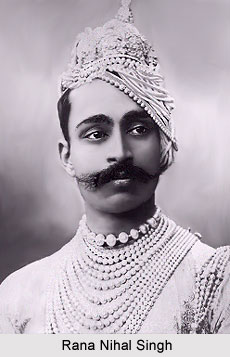 Rana Nihal Singh was the Jat ruler of the princely state of Dholpur, Rajasthan.
The princely state of Dholpur was a territory of eastern Rajputana that was founded by the Bamraulia clan Jat Rana rulers in 1806 AD. Dholpur was located in the current Indian state of Rajasthan. He was born on 4 May 1863 and belonged to the Bamraulia gotra or Dynasty of Jats. Nihal Singh was the son of Kulender Singh and eventually succeeded Rana Bhagwant Singh after his death on 9th February 1873. At the time when he ascended to the royal throne in the year 1873, Rana Nihal Singh was still a minor and merely eleven years of age. In the year 1884, Singh was bestowed with complete rights to rule over the princely state of Dholpur. He was the Maharaja Rana of Dholpur from the year 1873 till 1901. He was succeeded by Maharaja Rana Ram Singh.
Rana Nihal Singh was the Jat ruler of the princely state of Dholpur, Rajasthan.
The princely state of Dholpur was a territory of eastern Rajputana that was founded by the Bamraulia clan Jat Rana rulers in 1806 AD. Dholpur was located in the current Indian state of Rajasthan. He was born on 4 May 1863 and belonged to the Bamraulia gotra or Dynasty of Jats. Nihal Singh was the son of Kulender Singh and eventually succeeded Rana Bhagwant Singh after his death on 9th February 1873. At the time when he ascended to the royal throne in the year 1873, Rana Nihal Singh was still a minor and merely eleven years of age. In the year 1884, Singh was bestowed with complete rights to rule over the princely state of Dholpur. He was the Maharaja Rana of Dholpur from the year 1873 till 1901. He was succeeded by Maharaja Rana Ram Singh.
Rana Nihal Singh, adoringly called Pyare Raja Saheb by his subjects, completed his education under the training and guidance of his mother. She was the daughter Narender Singh, Maharaja of Patiala. He was educated in English language from 1873 to 1874 and was also well learned in Sanskrit, Hindi and other Persian languages. In 1875, he completed the settlement of land for the first time in Dholpur state. In the year 1876, Nihal Singh attended the Prince of Wales VII Adward Darbar held at Delhi.
Rana Nihal Singh was a good horseman. According to legends, the Maharaja Rana of Dholpur did relay horse riding against a train, and consequently He won the train under terms of agreement with British administration. The particular train remained in his ownership through out his reign. Rana Nihal Singh established various hospitals and expanded the network of roads and railways through out his kingdom. Moreover he renovated various structures and buildings and constructed water bodies in Dholpur. Due to his various progressive efforts for the development of the region and the betterment of the people, Rana Nihal Singh became one of the most renowned Jat rulers.
The Maharaja Rana received honorary Major in the Central India Horse and also attained the C.B. he got the Frontier Medal for services in the Tirah campaign. Rana Nihal Singh of Dholpur was married to the second daughter of Shah Dev Singh of Pandriganeshpur in Lahore on 30 April 1879. He died on 28th July 1901 and was succeeded by Rana Ram Singh.



















